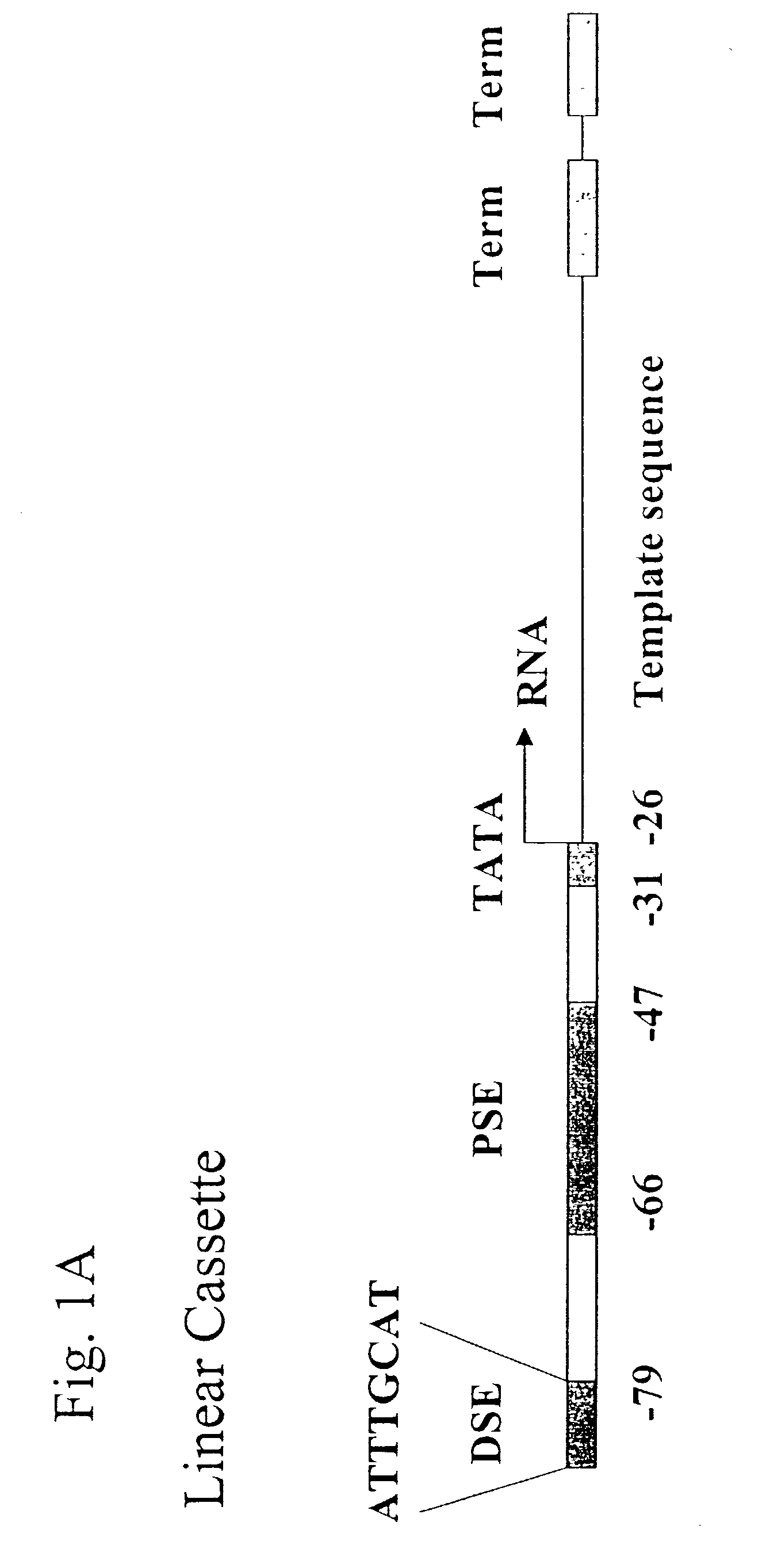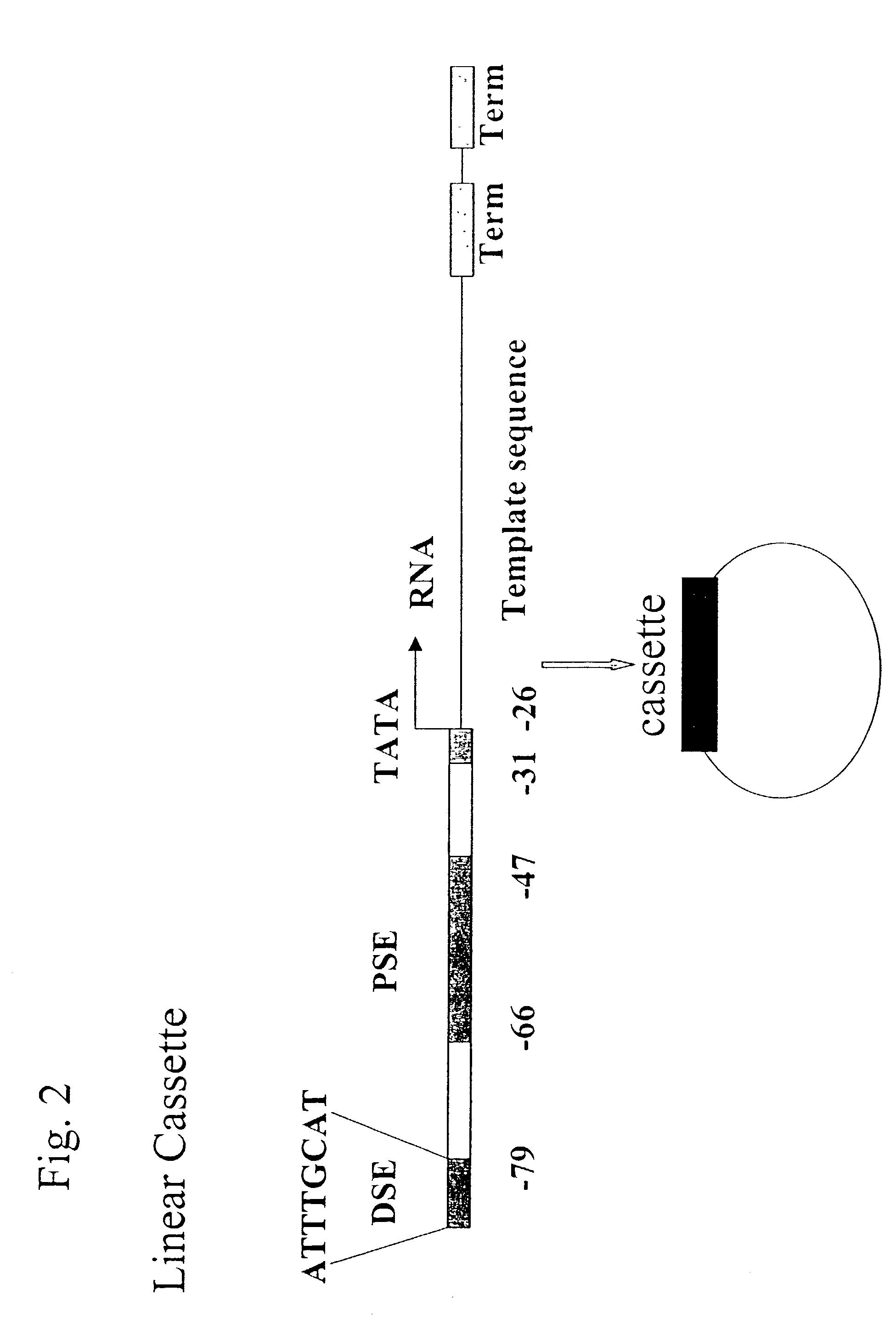Methods and compositions for DNA mediated gene silencing
a technology of dna and gene silencing, applied in the field of posttranscriptional gene silencing, can solve the problems of insufficient rnai inducers, conflicting data concerning the design and processing of such artificial shrnas to function as rnai inducers, and the method of introducing into cells either long or short dsrna molecules, isolated from in vitro or in vivo transcription, etc., to achieve the effect o
- Summary
- Abstract
- Description
- Claims
- Application Information
AI Technical Summary
Benefits of technology
Problems solved by technology
Method used
Image
Examples
example 1
Targeted mRNA Degradation by Linear DMSG Cassettes
[0137]Oligonucleotides for DMSG cassettes specific for a nucleotide sequence encoding green fluorescent protein (GFP) were synthesized at the Core Facility of Allele Biotechnology & Pharmaceuticals, Inc. (San Diego Calif.). In general, the expression cassette (from 5′ to 3′) consists of an enhancer region, the distal sequence element (DSE, −79 to −72 in reference to the transcription start site on the cassette) for pol III gene U6 (human), a proximal sequence element (PSE, −66 to −47) for pol III human gene U6, a TATA box (−31 to −26), followed by the template sequence (21 nucleotides), a terminator of the U6 gene, and an artificial terminator (“TM” or “Term”). For RO cassette, the terminators were omitted. A single expression cassette is composed of two DNA strands (sense strand and antisense strand) annealed together. The annealing was performed by incubating the two DNA strands in the annealing buffer (50 mM NaCl and 50 mM Tris-HC...
example 2
Mismatches on the Antisense Strand of the DMSG Cassette Affect Gene Silencing
[0151]The dsDNA encoding the sense RNA strand was the same as in Example 1 (SEQ ID NO:3 and SEQ ID NO:4). The sense strand of the dsDNA encoding the antisense RNA was also the same as in Example 1 (SEQ ID NO:7), whereas the antisense strand of the dsDNA contained mismatches compared to the GFP sequence. The TM DMSG(+) cassette encoding the sense RNA of a partial sequence of GFP was produced by annealing DNA oligonucleotides hP3GFTM(+)s and hP3GFPTM(+)as in Example 1. The DMSG(−) cassettes encoding the antisense RNA of the target sequence of GFP with various mutations were generated by annealing the hP3GFPTM(−)s with hP3GFPTM(−)asM1, M2, M3, or M4, respectively. The transfections were done as in Example 1.
[0152]The oligonucleotides, in which mismatched bases are in bold and italicized, were as follows:
[0153]hP3GFPTMasM1:
5′-CTAGcAAAAACtgtaaaAAGAACGGCATgAAGGTGAACggtgtttcgtcctttccacaagatatataaagcc cgaaatactttca...
example 3
DMSG Cassettes Assembled from Short Oligonucleotides Mediate Gene Silencing
[0158]Experimental methods are as in the previous examples, except that the dsDNA was assembled from shorter oligonucleotides (FIG. 3). DMSG cassettes can be more easily prepared from shorter oligonucleotides than a continuous long sequence. Assembling DMSG cassettes from short oligonucleotides has practical implications in that, for each gene silencing, one can only need to synthesize a pair of short oligonucleotides corresponding to a template sequence, which can then be assembled with other common oligonucleotides of other components of DMSG cassettes.
[0159]Short oligonucleotides, hP3GFPTM(−)s1, s2, s3, as1, and as2, were used to assemble the TM DMSG(−) cassette targeting GFP. Equal molars of these oligonucleotides were mixed and annealed as in Example 1, and then used for co-transfection with pEGFP and the TM DMSG(+) cassette targeting GFP. Transfection and cell cultural methods are the same as in Example...
PUM
| Property | Measurement | Unit |
|---|---|---|
| Gene expression profile | aaaaa | aaaaa |
Abstract
Description
Claims
Application Information
 Login to View More
Login to View More - R&D
- Intellectual Property
- Life Sciences
- Materials
- Tech Scout
- Unparalleled Data Quality
- Higher Quality Content
- 60% Fewer Hallucinations
Browse by: Latest US Patents, China's latest patents, Technical Efficacy Thesaurus, Application Domain, Technology Topic, Popular Technical Reports.
© 2025 PatSnap. All rights reserved.Legal|Privacy policy|Modern Slavery Act Transparency Statement|Sitemap|About US| Contact US: help@patsnap.com



